- GCN NOTICE
TITLE: GCN/FERMI NOTICE
NOTICE_DATE: Wed 15 Apr 20 08:48:30 UT
NOTICE_TYPE: Fermi-GBM Flight Position
RECORD_NUM: 44
TRIGGER_NUM: 608633290
GRB_RA: 347.100d {+23h 08m 24s} (J2000),
347.408d {+23h 09m 38s} (current),
346.336d {+23h 05m 21s} (1950)
GRB_DEC: -62.567d {-62d 34' 00"} (J2000),
-62.457d {-62d 27' 23"} (current),
-62.838d {-62d 50' 15"} (1950)
GRB_ERROR: 3.33 [deg radius, statistical plus systematic]
GRB_INTEN: 9314 [cnts/sec]
DATA_SIGNIF: 115.60 [sigma]
INTEG_TIME: 0.064 [sec]
GRB_DATE: 18954 TJD; 106 DOY; 20/04/15
GRB_TIME: 31685.56 SOD {08:48:05.56} UT
GRB_PHI: 75.00 [deg]
GRB_THETA: 20.00 [deg]
DATA_TIME_SCALE: 0.0640 [sec]
HARD_RATIO: 0.17
LOC_ALGORITHM: 3 (version number of)
MOST_LIKELY: 98% GRB
2nd_MOST_LIKELY: 1% Generic SGR
DETECTORS: 1,1,1, 1,1,1, 0,0,0, 1,1,0, 0,0,
SUN_POSTN: 23.97d {+01h 35m 52s} +9.99d {+09d 59' 12"}
SUN_DIST: 77.76 [deg] Sun_angle= 2.4 [hr] (West of Sun)
MOON_POSTN: 303.38d {+20h 13m 32s} -22.37d {-22d 22' 16"}
MOON_DIST: 49.84 [deg]
MOON_ILLUM: 46 [%]
GAL_COORDS: 321.37,-50.71 [deg] galactic lon,lat of the burst (or transient)
ECL_COORDS: 315.11,-50.66 [deg] ecliptic lon,lat of the burst (or transient)
LC_URL: http://heasarc.gsfc.nasa.gov/FTP/fermi/data/gbm/triggers/2020/bn200415367/quicklook/glg_lc_medres34_bn200415367.gif
COMMENTS: Fermi-GBM Flight-calculated Coordinates.
COMMENTS: This trigger occurred at longitude,latitude = 81.77,-23.97 [deg].
COMMENTS: The LC_URL file will not be created until ~15 min after the trigger.
- GCN NOTICE
TITLE: GCN/FERMI NOTICE
NOTICE_DATE: Wed 15 Apr 20 08:48:47 UT
NOTICE_TYPE: Fermi-GBM Ground Position
RECORD_NUM: 58
TRIGGER_NUM: 608633290
GRB_RA: 11.310d {+00h 45m 14s} (J2000),
11.531d {+00h 46m 07s} (current),
10.764d {+00h 43m 03s} (1950)
GRB_DEC: -60.410d {-60d 24' 35"} (J2000),
-60.299d {-60d 17' 56"} (current),
-60.683d {-60d 40' 59"} (1950)
GRB_ERROR: 1.00 [deg radius, statistical only]
DATA_SIGNIF: 124.70 [sigma]
DATA_INTERVAL: 0.064 [sec]
GRB_DATE: 18954 TJD; 106 DOY; 20/04/15
GRB_TIME: 31685.56 SOD {08:48:05.56} UT
GRB_PHI: 39.00 [deg]
GRB_THETA: 15.00 [deg]
E_RANGE: 44.032 - 279.965 [keV]
LOC_ALGORITHM: 4173 (Gnd S/W Version number)
SUN_POSTN: 23.97d {+01h 35m 52s} +9.99d {+09d 59' 12"}
SUN_DIST: 70.98 [deg] Sun_angle= 0.8 [hr] (West of Sun)
MOON_POSTN: 303.39d {+20h 13m 33s} -22.37d {-22d 22' 15"}
MOON_DIST: 59.92 [deg]
MOON_ILLUM: 46 [%]
GAL_COORDS: 304.33,-56.70 [deg] galactic lon,lat of the burst (or transient)
ECL_COORDS: 332.04,-56.76 [deg] ecliptic lon,lat of the burst (or transient)
LC_URL: http://heasarc.gsfc.nasa.gov/FTP/fermi/data/gbm/triggers/2020/bn200415367/quicklook/glg_lc_medres34_bn200415367.gif
POS_MAP_URL: http://gcn.gsfc.nasa.gov/notices_f/gbm_gnd_loc_map_608633290.fits
COMMENTS: Fermi-GBM Ground-calculated Coordinates.
COMMENTS: In the LAT Field-of-view.
COMMENTS: Bright hard burst in the GBM.
COMMENTS: This Notice was ground-generated -- not flight-generated.
COMMENTS: The LC_URL file will not be created/available until ~15 min after the trigger.
COMMENTS: The POS_MAP_URL file will not be created/available until ~1.5 min after the notice.
- GCN NOTICE
TITLE: GCN/FERMI NOTICE
NOTICE_DATE: Wed 15 Apr 20 08:57:28 UT
NOTICE_TYPE: Fermi-GBM Final Position
RECORD_NUM: 0
TRIGGER_NUM: 608633290
GRB_RA: 6.110d {+00h 24m 26s} (J2000),
6.362d {+00h 25m 27s} (current),
5.487d {+00h 21m 57s} (1950)
GRB_DEC: -32.040d {-32d 02' 23"} (J2000),
-31.928d {-31d 55' 39"} (current),
-32.317d {-32d 19' 00"} (1950)
GRB_ERROR: 2.02 [deg radius, statistical only]
GRB_DATE: 18954 TJD; 106 DOY; 20/04/15
GRB_TIME: 31685.56 SOD {08:48:05.56} UT
GRB_PHI: 26.00 [deg]
GRB_THETA: 43.00 [deg]
E_RANGE: 44.032 - 279.965 [keV]
LOC_ALGORITHM: 41731 (Gnd S/W Version number)
SUN_POSTN: 23.97d {+01h 35m 54s} +9.99d {+09d 59' 20"}
SUN_DIST: 45.17 [deg] Sun_angle= 1.2 [hr] (West of Sun)
MOON_POSTN: 303.47d {+20h 13m 52s} -22.36d {-22d 21' 37"}
MOON_DIST: 56.03 [deg]
MOON_ILLUM: 46 [%]
GAL_COORDS: 351.38,-82.35 [deg] galactic lon,lat of the burst (or transient)
ECL_COORDS: 351.35,-31.51 [deg] ecliptic lon,lat of the burst (or transient)
LC_URL: http://heasarc.gsfc.nasa.gov/FTP/fermi/data/gbm/triggers/2020/bn200415367/quicklook/glg_lc_medres34_bn200415367.gif
LOC_URL: http://heasarc.gsfc.nasa.gov/FTP/fermi/data/gbm/triggers/2020/bn200415367/quicklook/glg_locplot_all_bn200415367.png
COMMENTS: Fermi-GBM Final Position.
COMMENTS: This Notice was ground-generated -- not flight-generated.
COMMENTS: The LC_URL file should be available by the time this FINAL notice is produced.
COMMENTS: This notice was generated completely by automated pipeline processing.
COMMENTS: In the LAT Field-of-view.
COMMENTS: Bright hard burst in the GBM.
COMMENTS: This is likely a Short GRB.
- GCN Circular #27579
The Fermi GBM team reports the detection of a likely SHORT GRB
At 08:48:05 UT on 15 Apr 2020, the Fermi Gamma-ray Burst Monitor (GBM) triggered and located GRB 200415A (trigger 608633290.563746 / 200415367).
The on-ground calculated location, using the Fermi GBM trigger data, is RA = 6.1, Dec = -32.0 (J2000 degrees, equivalent to J2000 00h 24m, -32d 00'), with a statistical uncertainty of 2.0 degrees.
The angle from the Fermi LAT boresight is 43.0 degrees.
The skymap can be found here:
https://heasarc.gsfc.nasa.gov/FTP/fermi/data/gbm/triggers/2020/bn200415367/quicklook/glg_skymap_all_bn200415367.png
The HEALPix FITS file, including the estimated localization systematic, can be found here:
https://heasarc.gsfc.nasa.gov/FTP/fermi/data/gbm/triggers/2020/bn200415367/quicklook/glg_healpix_all_bn200415367.fit
The GBM light curve can be found here:
https://heasarc.gsfc.nasa.gov/FTP/fermi/data/gbm/triggers/2020/bn200415367/quicklook/glg_lc_medres34_bn200415367.gif
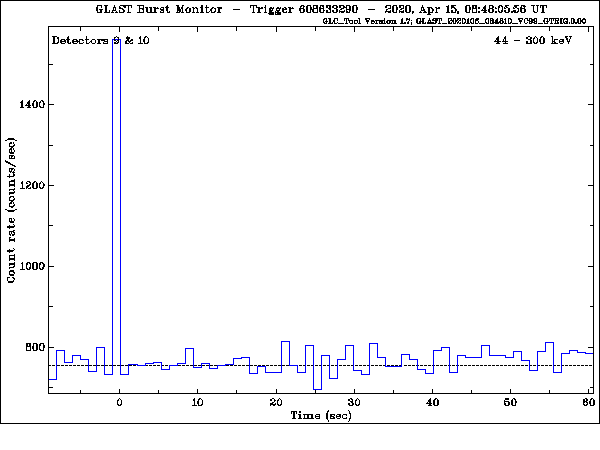
- GCN Circular #27580
F. Kunzweiler, B. Biltzinger, F. Berlato, J. Burgess & J. Greiner (all MPE Garching) report:
The public trigdat data of the Fermi Gamma-ray Burst Monitor (GBM) trigger
608633290 at 08:48:05 on 15 April 2020 were automatically fitted for spectrum
and sky location with BALROG (Burgess et al. 2018, MNRAS 476, 1427;
Berlato et al. 2019, ApJ 873, 60).
The best-fit position (1 sigma statistical errors) is:
RA(2000.0) = 10.8+/-6.4 deg
Decl.(2000.0) = -26.3+/-4.7 deg
We estimate an additional systematic error of 1 deg.
Further details are available at:
https://grb.mpe.mpg.de/grb/GRB200415367/
The Healpix map can be downloaded from:
https://grb.mpe.mpg.de/grb/GRB200415367/healpix
The location parameters are available as JSON at:
https://grb.mpe.mpg.de/grb/GRB200415367/json
- GCN Circular #27585
D. Svinkin, K. Hurley, and D. Frederiks, on behalf of the IPN,
I. G. Mitrofanov, D. V. Golovin, A. S. Kozyrev, M. L. Litvak,
and A. B. Sanin, on behalf of the HEND-Odyssey GRB team,
A. Goldstein, M. S. Briggs, and C. Wilson-Hodge
on behalf of the Fermi GBM team, and
A. von Kienlin, X. Zhang, A. Rau, V. Savchenko, E. Bozzo,
and C. Ferrigno, on behalf of the INTEGRAL SPI-ACS GRB team,
S. Barthelmy, J. Cummings, H. Krimm, and D. Palmer,
on behalf of the Swift-BAT team, and
W. Boynton, C. Fellows, K. Harshman, H. Enos, and R. Starr,
on behalf of the GRS-Odyssey GRB team, report:
The short-duration, extremely bright GRB 200415A
(Fermi-GBM detection: The Fermi GBM Team, GCN Circ. 27579;
BALROG localization : Kunzweiler, et al., GCN Circ. 27580)
has been detected by Fermi (GBM trigger 608633290), Konus-Wind,
INTEGRAL (SPI-ACS), Mars-Odyssey (HEND), and Swift (BAT),
so far, at about 31686 s UT (08:48:06).
The burst was outside the coded field of view of the BAT.
We have triangulated it to a preliminary, 3 sigma error box
whose coordinates are:
---------------------------------------------
RA(2000), deg Dec(2000), deg
---------------------------------------------
Center:
11.960 (00h 47m 50s) -25.937 (-25d 56' 13")
Corners:
11.481 (00h 45m 55s) -23.109 (-23d 06' 33")
11.740 (00h 46m 58s) -22.955 (-22d 57' 17")
12.354 (00h 49m 25s) -28.885 (-28d 53' 07")
12.073 (00h 48m 18s) -29.074 (-29d 04' 25")
---------------------------------------------
The error box area is 1.53 sq. deg, and its maximum
dimension is 6.126 deg (the minimum one is 15.4 arcmin).
The Sun distance was about 35 deg.
The IPN localization is consistent with, but reduces the area of,
the Fermi-GBM final position (GCN Circ. 27579) and
BALROG localization (GCN 27580).
The Fermi (GBM) light curve shows an extremely bright short pulse
with a duration of ~10 ms, followed, after a ~1 ms gap, by a decaying
emission lasting for ~150 ms. The light curve shape is very similar to
the extragalactic soft gamma-repeater giant flare candidates:
GRB 051103 - Frederiks et al., ApJL 33, 1, 19, 2007 (fig. 1 and 2) and
GRB 070201 - Mazets at al., ApJ 680, 1, 545, 2008 (fig. 1 and 2).
The IPN box contains a nearby Sculptor Galaxy (3.5 Mpc),
supporting the hypothesis of the magnetar Giant Flare nature
of the burst.
A triangulation map is posted at
http://www.ioffe.ru/LEA/GRBs/GRB200415_T31685/IPN/
Further localization improvements along with the burst time history and
spectrum will be given in forthcoming GCN Circulars.
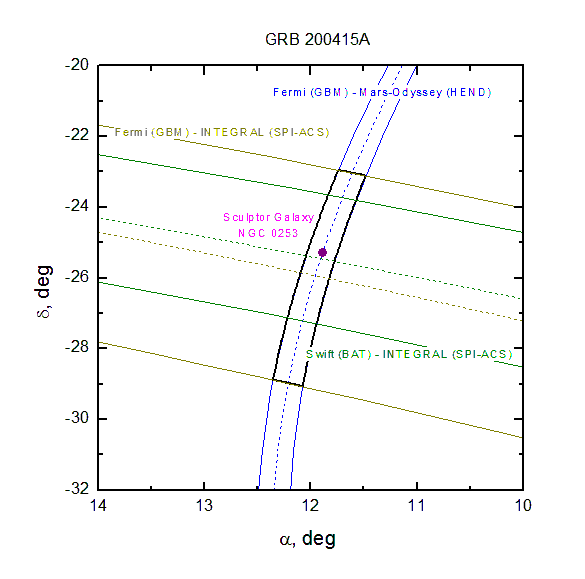
- GCN NOTICE
TITLE: GCN/FERMI NOTICE
NOTICE_DATE: Wed 15 Apr 20 17:48:30 UT
NOTICE_TYPE: Fermi-LAT Offline Position
TRIGGER_NUM: 608633290
GRB_RA: 11.000d {+00h 44m 00s} (J2000),
11.250d {+00h 45m 00s} (current),
10.384d {+00h 41m 32s} (1950)
GRB_DEC: -25.100d {-25d 06' 00"} (J2000),
-24.989d {-24d 59' 20"} (current),
-25.374d {-25d 22' 24"} (1950)
GRB_ERROR: 30.00 [arcmin radius, 90% containment, statistical only]
GRB_DATE: 18954 TJD; 106 DOY; 20/04/15
GRB_TIME: 31685.00 SOD {08:48:05.00} UT
TRIGGER_ID: 0x0
MISC: 0x40008000
SUN_POSTN: 24.31d {+01h 37m 16s} +10.12d {+10d 07' 11"}
SUN_DIST: 37.35 [deg] Sun_angle= 0.9 [hr] (West of Sun)
MOON_POSTN: 308.35d {+20h 33m 25s} -21.64d {-21d 38' 24"}
MOON_DIST: 57.34 [deg]
MOON_ILLUM: 42 [%]
GAL_COORDS: 83.06,-87.37 [deg] galactic lon,lat of the burst (or transient)
ECL_COORDS: 359.34,-27.25 [deg] ecliptic lon,lat of the burst (or transient)
COMMENTS: Fermi LAT Offline position.
COMMENTS: This Notice was ground-generated -- not flight-generated.
COMMENTS: It is the result of human-in-the-loop processing.
COMMENTS: This is a human generated position of a LAT ground detection.
COMMENTS: This source corresponds to GBM trigger.
- GCN Circular #27586
N. Omodei (Stanford University), M. Axelsson (KTH & Stockholm Univ.), F. Piron (CNRS/IN2P3/LUPM), F. Longo (University and INFN, Trieste), D. Kocevski (NASA/MSFC), E. Bissaldi (Politecnico & INFN Bari) and A. Berretta (University & INFN Perugia)
report on behalf of the Fermi-LAT Collaboration:
On April 15, 2020, Fermi-LAT detected high-energy emission from GRB 200415A, which was also detected by Fermi-GBM (trigger 608633290/200415367).
The GRB is marginally detected at high energy (>100 MeV) by Fermi-LAT at a location of:
RA, Dec = 11.0, -25.1 (degrees, J2000) with an error radius of 0.5 deg (90% containment, statistical error only).
This was 49 deg from the LAT boresight at the time of the GBM trigger, T0 = 08:48:05.56 UT, and 8.1 deg from the GBM final ground position (The Fermi GBM team, GCN27579). The location is also consistent within errors with the location from the IPN (Svinkin et al., GCN27585).
The photon flux above 100 MeV in the time interval 0-500 seconds after the GBM trigger is 3.4e-06 +/- 2.1e-06 ph/cm^2/s. The estimated photon index above 100 MeV is -1.7 +/ - 0.3. The highest-energy photon is a 1.7 GeV event, which is observed 284 seconds after the GBM trigger.
The Fermi-LAT point of contact for this burst is:
Alessandra Berretta (alessandra.berretta@pg.infn.it).
The Fermi-LAT is a pair conversion telescope designed to cover the energy band from 20 MeV to greater than 300 GeV. It is the product of an international collaboration between NASA and DOE in the U.S. and many scientific institutions across France, Italy, Japan and Sweden.
- GCN Circular #27587
E. Bissaldi (Politecnico and INFN Bari), M. Briggs (UAH),
E. Burns (GSFC), O.J. Roberts (USRA) and P. Veres (UAH)
report on behalf of the Fermi GBM Team:
"At 08:48:05.56 UT on 15 April 2020, the Fermi Gamma-Ray Burst Monitor (GBM)
triggered and located GRB 200415A (trigger 608633290 / 200415367),
which was also detected by Fermi-LAT (Omodei et al., GCN 27586).
The Fermi GBM Final Real-time Localization (GCN 27579)
is consistent with the LAT position.
The angle from the Fermi LAT boresight
at the GBM trigger time is 49 degrees.
The GBM light curve shows a bright single pulse
with a duration (T90) of about 0.2 s (50-300 keV).
The time-averaged spectrum from T0-0.032 s to T0+0.160 s is
adequately fit by a power law function with an exponential
high-energy cutoff. The power law index is 0.07 +/- 0.05 and
the cutoff energy, parameterized as Epeak, is 950 +/- 40 keV.
The event fluence (10-1000 keV) in this time interval
is (5.2 +/- 0.1)E-06 erg/cm^2. The 64-ms peak photon flux
measured starting from T0 in the 10-1000 keV band
is 74 +/- 2 ph/s/cm^2.
While we report the source to be a possible short GRB,
we cannot conclusively rule out a giant magnetar flare
of extragalactic origin, as reported by IPN (GCN 27585).
Periodicity is not evident in the GBM data.
Assuming a distance of 3.5 Mpc and the spectral shape reported above,
the isotropic equivalent energy in the 1 keV-10 MeV range is
(1.22 +/- 0.03)E+46 erg. Further analysis is ongoing.
The spectral analysis results presented above are preliminary;
final results will be published in the GBM GRB Catalog:
https://heasarc.gsfc.nasa.gov/W3Browse/fermi/fermigbrst.html
For Fermi GBM data and info, please visit the official Fermi GBM Support Page:
https://fermi.gsfc.nasa.gov/ssc/data/access/gbm/"
- GCN Circular #27590
V. Lipunov, E. Gorbovskoy, V.Kornilov, N.Tyurina, P.Balanutsa, A.Kuznetsov, F.Balakin,
V.Vladimirov, D. Vlasenko, I.Gorbunov, D.Zimnukhov, V.Senik, T.Pogrosheva,
D.Kuvshinov, D. Cheryasov
(Lomonosov Moscow State University, SAI, Physics Department),
R. Podesta, C.Lopez, F. Podesta, C.Francile
(Observatorio Astronomico Felix Aguilar OAFA),
H.Levato
(Instituto de Ciencias Astronomicas, de la Tierra y del Espacio ICATE),
R. Rebolo, M. Serra
(The Instituto de Astrofisica de Canarias),
D. Buckley
(South African Astronomical Observatory),
O.A. Gres, N.M. Budnev, O.Ershova
(Irkutsk State University, API),
A. Tlatov, D. Dormidontov
(Kislovodsk Solar Station of the Pulkovo Observatory),
V. Yurkov, A. Gabovich, Yu. Sergienko
(Blagoveschensk Educational State University)
MASTER-SAAO robotic telescope (Global MASTER-Net: http://observ.pereplet.ru, Lipunov et al., 2010, Advances in Astronomy, vol. 2010, 30L) located in South Africa (South African Astronomical Observatory) started inspect of the Fermi GRB 200415A ( Fermi GBM team, GCN 27579) errorbox 59974 sec after notice time and 60005 sec after trigger time at 2020-04-16 01:28:11 UT, with upper limit up to 18.9 mag. The observations began at zenith distance = 74 deg. The sun altitude is -45.2 deg.
The galactic latitude b = -57 deg., longitude l = 304 deg.
Real time updated cover map and OT discovered available here:
https://master.sai.msu.ru/site/master2/observ.php?id=1337394
We obtain a following upper limits.
Tmid-T0 | Date Time | Site | Coord (J2000) |Filt.| Expt. | Limit| Comment
_________|_____________________|_____________________|____________________________________|_____|_______|_______|________
60036 | 2020-04-16 01:28:11 | MASTER-SAAO | (00h 26m 38.28s , -62d 06m 18.6s) | C | 60 | 18.4 |
60040 | 2020-04-16 01:28:15 | MASTER-SAAO | (00h 41m 32.15s , -62d 05m 14.4s) | C | 60 | 18.0 |
62934 | 2020-04-16 02:16:29 | MASTER-SAAO | (00h 26m 30.17s , -62d 06m 01.0s) | C | 60 | 18.9 |
62938 | 2020-04-16 02:16:33 | MASTER-SAAO | (00h 41m 27.25s , -62d 04m 57.1s) | C | 60 | 18.7 |
63014 | 2020-04-16 02:17:49 | MASTER-SAAO | (00h 24m 54.86s , -60d 05m 54.9s) | C | 60 | 18.9 |
63018 | 2020-04-16 02:17:53 | MASTER-SAAO | (00h 38m 56.88s , -60d 04m 50.7s) | C | 60 | 18.8 |
63097 | 2020-04-16 02:19:12 | MASTER-SAAO | (00h 36m 38.06s , -58d 03m 33.9s) | C | 60 | 18.6 |
63173 | 2020-04-16 02:20:28 | MASTER-SAAO | (00h 53m 41.50s , -58d 06m 07.0s) | C | 60 | 18.6 |
63946 | 2020-04-16 02:33:21 | MASTER-SAAO | (00h 24m 52.11s , -60d 06m 10.1s) | C | 60 | 18.6 |
63950 | 2020-04-16 02:33:25 | MASTER-SAAO | (00h 38m 49.79s , -60d 05m 07.9s) | C | 60 | 18.6 |
64029 | 2020-04-16 02:34:45 | MASTER-SAAO | (00h 36m 38.94s , -58d 04m 49.4s) | C | 60 | 18.5 |
64105 | 2020-04-16 02:36:00 | MASTER-SAAO | (00h 53m 43.98s , -58d 04m 24.7s) | C | 60 | 18.3 |
Filter C is a clear (unfiltred) band.
The observation and reduction will continue.
The message may be cited.
- GCN Circular #27595
D. Svinkin, S. Golenetskii, R. Aptekar, D. Frederiks, A. Ridnaia,
and T. Cline on behalf of the Konus-Wind team,
K. Hurley on behalf of the IPN,
I. G. Mitrofanov, D. V. Golovin, A. S. Kozyrev, M. L. Litvak,
and A. B. Sanin, on behalf of the HEND-Odyssey GRB team,
A. Goldstein, M. S. Briggs, and C. Wilson-Hodge
on behalf of the Fermi GBM team, and
A. von Kienlin, X. Zhang, A. Rau, V. Savchenko, E. Bozzo,
and C. Ferrigno, on behalf of the INTEGRAL SPI-ACS GRB team,
S. Barthelmy, J. Cummings, H. Krimm, and D. Palmer,
on behalf of the Swift-BAT team, and
W. Boynton, C. Fellows, K. Harshman, H. Enos, and R. Starr,
on behalf of the GRS-Odyssey GRB team, report:
Using the Konus-Wind data we have
triangulated this GRB to an improved, but still preliminary,
3 sigma error box whose coordinates are:
---------------------------------------------
RA(2000), deg Dec(2000), deg
---------------------------------------------
Center:
11.874 (00h 47m 30s) -25.194 (-25d 11' 37")
Corners:
11.760 (00h 47m 02s) -25.393 (-25d 23' 34")
12.022 (00h 48m 05s) -25.302 (-25d 18' 09")
11.987 (00h 47m 57s) -24.994 (-24d 59' 38")
11.726 (00h 46m 54s) -25.085 (-25d 05' 05")
---------------------------------------------
The error box area is about 274 sq. arcmin, and its maximum
dimension is 27 arcmin (the minimum one is 14.7 arcmin).
The Sun distance was about 37 deg.
This error box reduces the initial error box (Svinkin et al.,
GCN Circ. 27585). The Sculptor Galaxy (NGC 253) is mostly inside
the box, strengthen the association the burst with the galaxy
proposed in GCN 27585.
We encourage an extensive search, both retrospective and
follow-up, for an accompanying radio emission.
This box may be further improved.
A triangulation map is posted at
http://www.ioffe.ru/LEA/GRBs/GRB200415_T31685/IPN/
The Swift (BAT) event data used for the IPN localization
came from the GUANO system (https://www.swift.psu.edu/guano/).
The Konus-Wind time history and spectrum will be given in a forthcoming
GCN Circular.
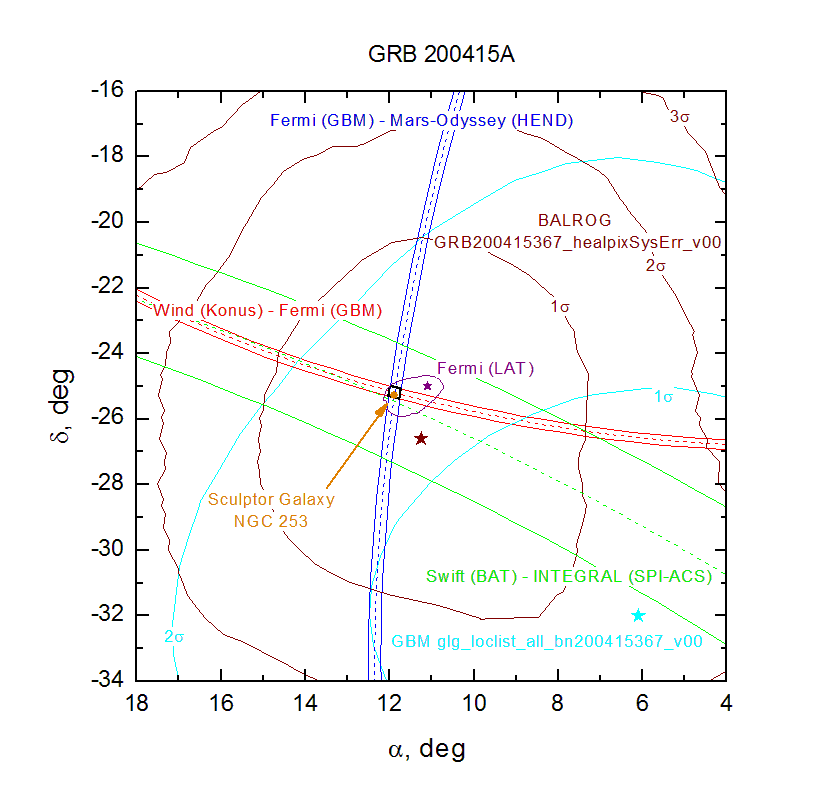
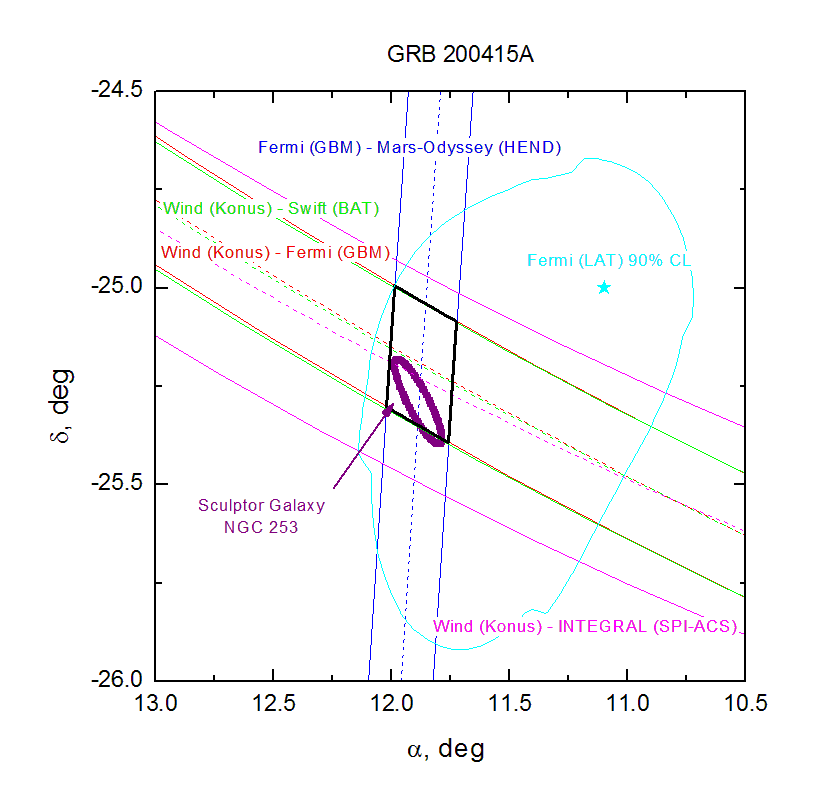
- GCN Circular #27596
D. Frederiks, S. Golenetskii, R. Aptekar, A. Lysenko,
A. Ridnaia, D. Svinkin, A. Tsvetkova, M. Ulanov, and T. Cline,
on behalf of the Konus-Wind team, report:
The extremely-bright, short-duration GRB 200415A
(IPN localization: Svinkin et al., GCN Circ. 27585, 27595;
Fermi-GBM observation: Bissaldi et al., GCN Circ. 27587)
triggered Konus-Wind at T0=31681.401 s UT (08:48:01.401).
The burst light curve starts at ~T0-2 ms with the sharp
rise of extremely-bright pulse, with a duration of ~5 ms.
This pulse is followed by a weaker, steadily decaying
emission which is visible up to ~T0+200 ms.
The emission is seen up to ~10 MeV.
As observed by Konus-Wind, the burst had a fluence of
8.1(-0.8, +0.9)x10^-6 erg/cm2,
and a 2-ms peak flux, measured from T0-0.002 s,
of 1.0(-0.08,+0.08)x10^-3 erg/cm2/s
(both in the 20 keV - 10 MeV energy range).
The time-integrated spectrum (measured from T0 to T0+0.192 s)
is best fit in the 20 keV - 15 MeV range
by a power law with exponential cutoff (CPL) model:
dN/dE ~ (E^alpha)*exp(-E*(2+alpha)/Ep)
with alpha = +0.10(-0.23,+0.27)
and Ep = 818(-112,+136) keV (chi2 = 34/49 dof).
Fitting by a GRB (Band) model yields similar alpha and Ep,
and an upper limit on the high energy photon index: beta < -2.5
(chi2 =33/49 dof).
The spectrum measured near the peak count rate (from T0 to T0+0.064 s)
is best fit in the 20 keV - 15 MeV range by the CPL model
with alpha = +0.12(-0.24,+0.20) and Ep = 1060(-160,+190) keV
(chi2 = 25/36 dof). Fitting by a GRB (Band) model yields similar
alpha and Ep, and an upper limit on the high energy photon index:
beta < -2.6 (chi2 =24/35 dof).
Assuming the likely GRB 200415A association with the nearby Sculptor
galaxy at ~3.5 Mpc (Svinkin et al., GCN 27585, GCN 27595),
we estimate the burst isotropic energy to ~1.3x10^46 erg and
the 2-ms peak luminosity to ~1.6x10^48 erg/s.
These values closely resemble the energetics of the initial pulse of
the SGR 1806-20 giant magnetar flare (GF) measured by KW and HELICON
(Frederiks et al., 2007 AstL 33 1).
GRB 200415A also shows a striking similarity, in light curve, spectrum,
and energy, with GRB 051103 (Frederiks et al., 2007 AstL 33 19),
the extragalactic GF candidate in the M81/M82 group of galaxies
located at nearly the same distance, ~3.6 Mpc.
Even the giant magnetar flare origin of GRB 200415A and GRB 051103
cannot be established unequivocally (the key evidence, pulsating tail,
could hardly be detected by KW or Fermi-GBM from ~3.5 Mpc),
the common nature of the two ultra-bright flares is highly probable.
The Konus-Wind light curve of GRB 200415A is available at
http://www.ioffe.ru/LEA/GRBs/GRB200415_T31681/
A comparison of Konus-Wind light curves of GRB 200415A and GRB 051103
can be found at http://www.ioffe.ru/LEA/GRBs/GRB200415_T31681/051103_200415.pdf
All the quoted errors are at the 90% confidence level.
All the quoted values are preliminary.
- GCN Circular #27597
N. Omodei (Stanford University), F. Piron (CNRS/IN2P3/LUPM), M. Axelsson (KTH & Stockholm Univ.), F. Longo (University and INFN, Trieste), D. Kocevski (NASA/MSFC), E. Bissaldi (Politecnico & INFN Bari) and A. Berretta (University & INFN Perugia)
report on behalf of the Fermi-LAT Collaboration:
We performed additional analysis to estimate the localization contour of GRB 200415A detected at high energy by Fermi-LAT (GCN 27586).
The best localization is at: R.A., Dec. = 11.07, -25.02 (degrees, J2000) with a circular error of 0.38 and 0.59 degrees (statistical only), respectively at 68% and 90% confidence levels.
The shape of the contour shows an elongation toward the location of the IPN error box (GCN 27595) placing the Sculptor Galaxy (NGC 253) between the 68% and the 90% c.l. contours.
A localization map is posted at:
https://www-glast.stanford.edu/pub_data/1775/GRB200415A_TSMAP_LAT.gif
The Fermi-LAT point of contact for this burst is Alessandra Berretta (alessandra.berretta@pg.infn.it).
The Fermi-LAT is a pair conversion telescope designed to cover the energy band from 20 MeV to greater than 300 GeV.
It is the product of an international collaboration between NASA and DOE in the U.S. and many scientific institutions across France, Italy, Japan and Sweden.
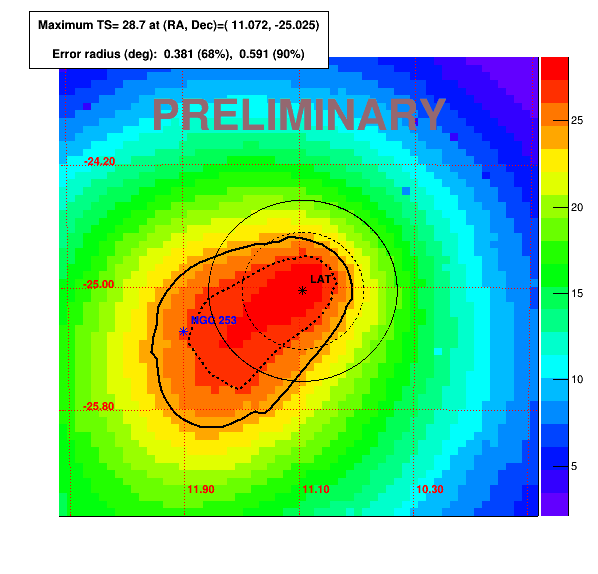
- GCN Circular #27599
V. Lipunov, N.Tyurina,
E. Gorbovskoy, V.Kornilov, P.Balanutsa,A.Kuznetsov,F.Balakin,
V.Vladimirov, D. Vlasenko, I.Gorbunov, D.Zimnukhov, V.Senik, T.Pogrosheva,
D.Kuvshinov(Lomonosov Moscow State University, SAI, Physics Department),
A. Tlatov, D. Dormidontov (Kislovodsk Solar Station of the Pulkovo Observatory),
R. Podesta, C.Lopez, F. Podesta, C.Francile(Observatorio Astronomico Felix
Aguilar OAFA),
H. Levato(Instituto de Ciencias Astronomicas, de la Tierra y del Espacio
ICATE),
R. Rebolo, M. Serra(The Instituto de Astrofisica de Canarias),
D. Buckley(South African Astronomical Observatory),
O.A. Gres, N.M. Budnev, O.Ershova (Irkutsk State University, API),
V. Yurkov, A. Gabovich, Yu. Sergienko(Blagoveschensk Educational State
University)
MASTER OTJ 004724.94-252125.6s (AT2020hok)
MASTER-SAAO auto-detection system ( Lipunov et al., "MASTER Global Robotic
Net", Advances in Astronomy, 2010, 30L )
proposed interesting source at (RA, Dec) = 00h 47m 24.94s -25d 21m 25.6s
on 2020-04-17.15061 UT during GRB 200415 error box inspection
(GCN 27579; 27580; 27586; 27595; 27597;).
Inside galaxy NGC 0253 (Svinkin, 27595; Frederiks 27597;) there
is an interesting extended object with an XMM X-ray source at 00 47
25.0800 -25 21 23.760 .
This is may be globular cluster: B-V ~ 1
The unfiltered magnitude is 15.8m (mlim 17.9).
The source is seen in 24 images. No optical variability detected.
We have reference image on 2018-08-10.99113 UT with unfiltered
mlim=20.3m.
Follow up observations are required.
The cover map is available at
https://master.sai.msu.ru/site/master2/event.php?id=1337630
The inspection and reference images are available at:
http://master.sai.msu.ru/static/OT/183315.33623157.0.png
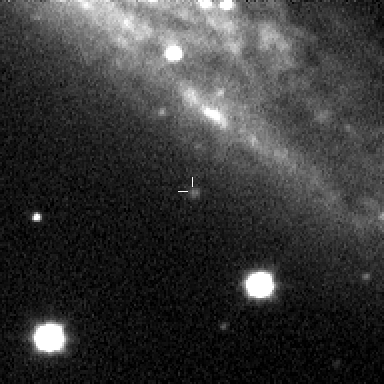
- GCN Circular #27622
M. Marisaldi (University of Bergen), A. Mezentsev (University of Bergen),
N. Ųstgaard (University of Bergen), V. Reglero (University of Valencia)
and T. Neubert (DTU Space) report on behalf of the ASIM Team:
At 08:48:05.557 UT on 15 April 2020, the Atmosphere-Space Interactions Monitor (ASIM)
mission triggered on the very bright GRB 200415A (GCN Circ. 27579, 27580,
27585, 27586, 27587, 27590, 27595, 27596, 27597, 27599).
Photon by photon data with <1 microsecond time resolution have been
collected for a time interval of two seconds centered at the trigger time.
As seen by the Modular X- and Gamma-Ray Sensor (MXGS) onboard ASIM
the burst consists of a bright peak about 6 ms in duration, followed by a steadily
decaying tail at least 200 ms long. The emission is detected in both
the MXGS Low Energy Detector (LED), sensitive in the range 0.05 to 0.4 MeV,
and in the High Energy Detector (HED), sensitive in the range 0.3 to >30 MeV.
Significant emission is observed up to several MeV.
Further data analysis is ongoing and will be published elsewhere.
ASIM is an ESA mission onboard the International Space Station dedicated to the
observation of Terrestrial Gamma-ray Flashes (TGFs) and Transient Luminous Events (TLEs)
operative since June 2018 (Neubert et al., Space Sci Rev (2019) 215:26
https://doi.org/10.1007/s11214-019-0592-z ).
The payload includes the Modular X- and Gamma-Ray Sensor (MXGS)
(Ųstgaard et al., Space Sci Rev (2019) 215:23 https://doi.org/10.1007/s11214-018-0573-7 ),
and the the Modular Multispectral Imaging Array (MMIA)
(Chanrion et al., Space Sci Rev (2019) 215:28 https://doi.org/10.1007/s11214-019-0593-y ).
The ASIM Science Data Centre (ASDC) website is https://asdc.space.dtu.dk/
- GCN Circular #27627
A. Pozanenko (IKI), P. Minaev (IKI), I. Chelovekov (IKI), S. Grebenev
(IKI) report on behalf of GRB IKI FuN:
We analysed publicly available INTEGRAL data around the time of GRB
200415A (Fermi GBM team, GCN 27579; Omodei et al., GCN 27586; Frederiks
et al., GCN 27596; Marisaldi et al., GCN 27622). Direction to GRB
200415A localization by IPN (Svinkin et al., GCN 27585) and Fermi LAT
(Omodei et al., GCN 27597) is 89 degrees off-axis for INTEGRAL
telescopes, which is nearly optimal for the SPI-ACS detector. This event
did not trigger IBAS (see
http://www.isdc.unige.ch/integral/science/grb#ACS).
The GRB 200415A is clearly visible in SPI-ACS, IBIS/ISGRI and
IBIS/PICsIT (for latter two - outside the FoV). Using IBIS/ISGRI we
derived the GRB 200415A time interval from T0+0.38 up to T0+0.52, where
T0 = 2020-04-15T08:48:05.56 (UT) is the trigger time of GRB Fermi.
Duration of GRB 200415A is 0.20 s as seen in SPI-ACS and 0.14 c in
IBIS/ISGRI in 30-500 keV energy band. The fluence of the event in
SPI-ACS is 27800 +/- 300 cts, which is equivalent to 6.7Šµ-6 ergs/cm2 in
10-1000 keV energy (1.2Šµ-6 -- 3.8Šµ-5 ergs/cm2 is the 95% confident
region using calibration of SPI-ACS for short Pozanenko et al.,
Astronomy Letters, 45, 11, 710 (2019). The fluence of the event in ISGRI
is 3.2 +/- 2.2e-6 ergs/cm2 (30-100 keV) and 3.7 +/- 2.4e-6 ergs/cm2
(100-500 keV) after calibration of ISGRI (Chelovekov et al., Astronomy
Letters, 45, 10, 635 (2019).
We detected neither any precursor within 200 s prior the trigger, nor
significant extended emission up to +100 s.
Light curves of the GRB 200415A registered by INTEGRAL detectors can be
found at
http://grb.rssi.ru/GRB200415A_ISGRI_PICSIT_ACS.png
We note a possible multi-pulse structure of the event as can be seen in
the IBIS/ISGRI light curve.
We also put the spectral data reported (Bissaldi et al., GCN 27587;
Frederiks et al., GCN 27596) onto E_iso -- E_p diagram (AKA Amati
relation) and EHD diagram (Minaev et al., MNRAS, 492, 1919 (2020).
If GRB 200415A is a real gamma-ray burst its redshift should be z > 0.03
as it is seen from the event trajectory in the diagrams.
We put the Giant Flare (GF) of SGR 1806-20 on 2004-12-27 on the E_iso --
E_p diagram and found that position of GRB 200415A, if its source in
Sculptor galaxy (NGC 253) at 3.5 Mpc, is compatible with the position
of the GF of SGR 1806-20 on 2004-12-27 (see Figures below).
E_iso -- E_p diagram (AKA Amati relation) and EHD diagram can be found at
http://grb.rssi.ru/GRB200415A/GRB200415A_Amati_SGR.png
http://grb.rssi.ru/GRB200415A/GRB200415A_EHD_SGR.png
- GCN Circular #27629
A. Pozanenko (IKI), P. Minaev (IKI), I. Chelovekov (IKI), S. Grebenev
(IKI) report on behalf of GRB IKI FuN:
The correct URL for light curves of GRB 200415A registered by INTEGRAL
detectors can be found at
http://grb.rssi.ru/GRB200415A/GRB200415A_ISGRI_PICSIT_ACS.png
We apologize for inconvenience.
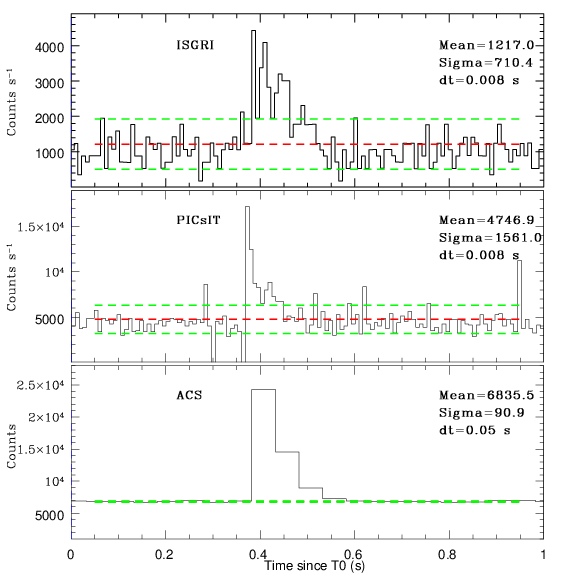
![]() Previous IAU Circulars
Previous IAU Circulars 





